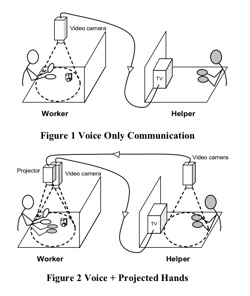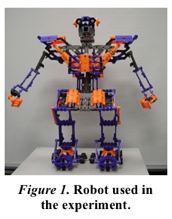Kirk, D., Rodden, T., and Fraser, D. S. Turn it this way: grounding collaborative action with remote gestures. In CHI ’07: Proceedings of the SIGCHI conference on Human factors in computing systems (New York, NY, USA, 2007), ACM Press, pp. 1039–1048. [pdf]
———-
This paper present a fundamental study for my thesis work. The authors enquired the ability of remote gesturing tools to imporve distance collaborations performance. The authors reported a suggestion from previous work stating that complex gestures rather than simple deixis are responsible for performance enhancement (Fussell et al., 2004).
Their specific question was to understand the impact of complex remote gestures with language taking into consideration the temporal nature of the grounding process. Particularly, performance benefit derived from the use of a remote gesture tool is based on its ability to affect the process of developing common ground (Kirk, D. S., and Stanton Fraser, D., 2006).
Complex use of gestures in interaction can have a variety of other uses in collaborative discourse such as helping to marshal turn-taking and to signal understanding.
The authors use a helper-worker paradigm where the task at hand was the reconstruction of a lego model from diagrammatic instructions. “The system was constructed such that both participants would be in the same room during the study, but only had visual access to each other and each other’s desks through the mediating technology – partitions ensuring that direct visual access was blocked. This enabled us to retain full audio in all conditions without having to use any audio communications technology. Participants were allowed to speak to one another at all times during the study.”

They demonstrated how performance benefits of remote gesture tools appear to be strangest during early stages of an interaction, when remote gestures have the potential to reduce the amount of Workers’ speech. Independently of the phase, questioning behavior from the workers is slightly lessened by gesturing. Also, gesturing is associated with a reduction in the occurrence of speech overlaps.
Their findings demonstrated that performance improvements, already demonstrated by (Fussell et al., 2004) was still true when the remote gestures format was altered from a digital sketch to an unmediated representation of hands.
The authors finally discuss some implications for the deployment of remote gesturing technologies. They suggest three cooperative arrangements that fits into ideal applications of this form of technology.
(1) Non-Routing physical manipulations, where the nature of the task and the settings vary considerably and each cooperative iteration requires significant effort to ground the interaction.
(2) Regular changes in the participants, where common vocabulary of frames of references have to be reestablished frequently.
(3) Rapid cooperative diagnosis settings, where rapid coordination is required in order to decide the best possible actions.




